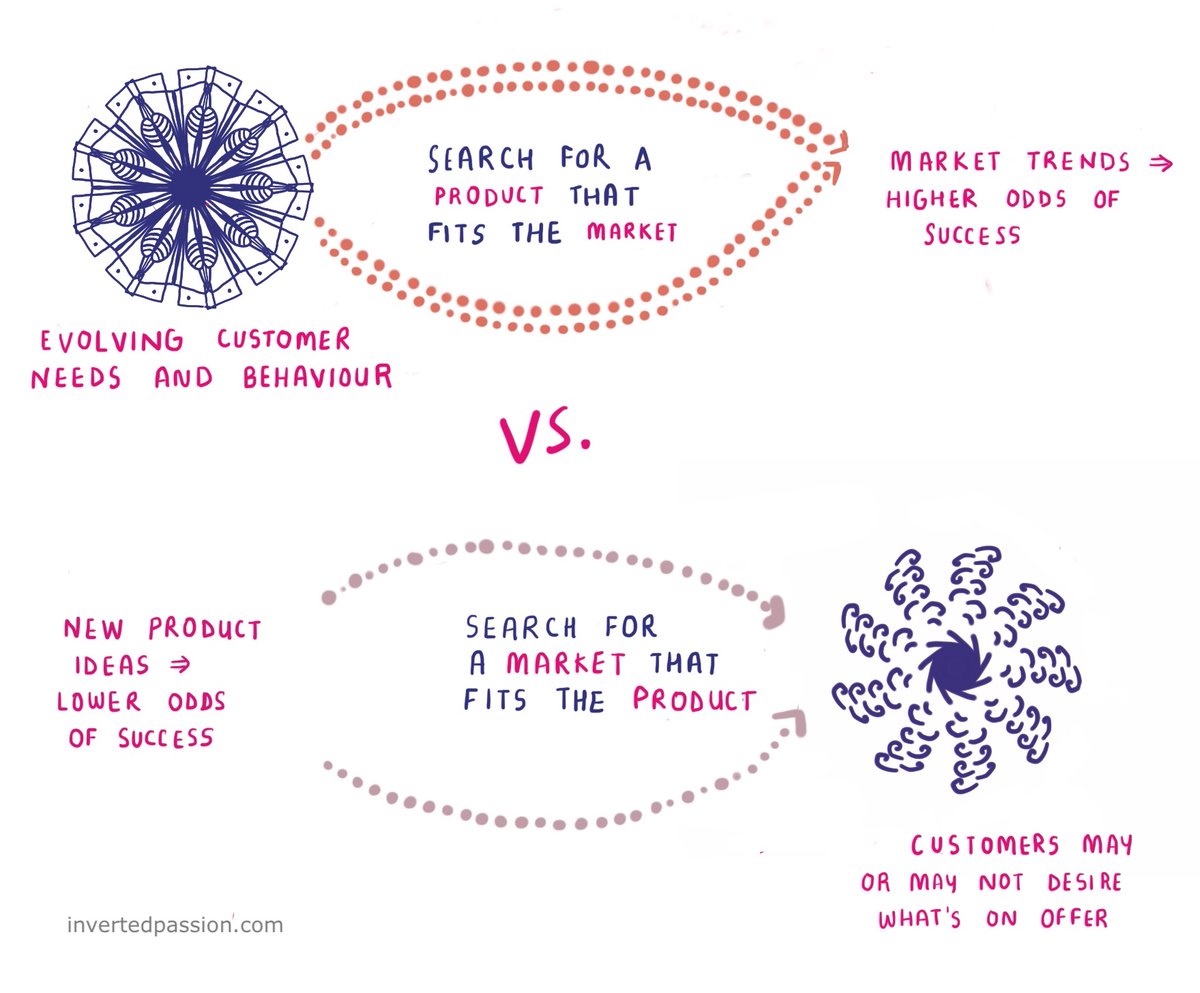Search for market-product fit, not product-market fit
(a short thread on this mental model)
 It's also the 5th chapter of my new book https://invertedpassion.com/product-market-fit/
It's also the 5th chapter of my new book https://invertedpassion.com/product-market-fit/
(a short thread on this mental model)
 It's also the 5th chapter of my new book https://invertedpassion.com/product-market-fit/
It's also the 5th chapter of my new book https://invertedpassion.com/product-market-fit/
1/ It’s near impossible for a product to create a new desire in customers all by itself. No single product creates a market.
Multiple environmental, political, economic, social, and technological factors come together to delicately and gradually shape what customers desire.
Multiple environmental, political, economic, social, and technological factors come together to delicately and gradually shape what customers desire.
2/ That collective process, which is beyond any single company, creates an opening for new products to address evolved customer expectations.
The million dollar question is: how do you discover these evolving trends?
The million dollar question is: how do you discover these evolving trends?
3/ The best way to discover these unambiguous market trends is to look for instances where customers are innovating by themselves by modifying or re-imagining existing products.
4/ Innovative customers have guided entrepreneurs throughout history - from lugging big stereo systems which led to the inspiration for portable music players to scooting their cars off the paved road which led to the inspiration for SUVs.
5/ Researching why customers are doing what they’re doing can provide deep insights into their desires. Maybe not all people want cars to satisfy their desire to go from point A to point B.
Maybe some want cars to satisfy their adventure desire? https://invertedpassion.com/why-do-businesses-exist/
Maybe some want cars to satisfy their adventure desire? https://invertedpassion.com/why-do-businesses-exist/
6/ In short: to discover trends pay close attention to what people do (not what they say)
Wrote about this here: https://invertedpassion.com/evidence-of-desire-customer-behavior/
Wrote about this here: https://invertedpassion.com/evidence-of-desire-customer-behavior/
7/ Another way to discover good business opportunities is to take the latest innovations in technology and imagine how can such innovations offer a radically better solution for existing customer desires.
8/ When Salesforce launched its cloud-based CRM in 1999, the CRM industry was well-established with offerings from IT giants who offered their CRM software on-premise (i.e. businesses had to build their own data servers and purchase servers to install and host CRM software)
9/ What Marc Benioff cleverly observed was that the dot com boom of the 1990s meant that software access could now be provided over the Internet. Benioff took the cloud boom that was driven by online consumer retail, and applied it to business software.
10/ Note that Salesforce didn’t create the desire for CRM – managing customer database is a human need as old as businesses existed. What they did was to take upcoming technology and apply it to serve the same customer need in a cheaper, better and faster way.
11/ In short: think of which existing human desires can be better fulfilled by currently emerging technology and you have a good business opportunity.
Wrote about this earlier: https://invertedpassion.com/jobs-to-be-done/
Wrote about this earlier: https://invertedpassion.com/jobs-to-be-done/
12/ It’s risky to get excited about an idea first and then go about researching the market.
The excitement for an idea will cloud your judgment and inevitably lead you to find confirmatory evidence for it while rejecting all the contradicting evidence.
The excitement for an idea will cloud your judgment and inevitably lead you to find confirmatory evidence for it while rejecting all the contradicting evidence.
13/ Remember: following your passion is usually a terrible business advice.
Wrote about it here: https://invertedpassion.com/capitalism-rewards-rare-and-valuable/
Wrote about it here: https://invertedpassion.com/capitalism-rewards-rare-and-valuable/
14/ Therefore, rather than starting with an idea and then doing research, it’s much better to start with a blank slate and start observing customer behavior and trends.
Sooner or later, you’ll find yourself full of bright ideas that are derived from actual customer behavior.
Sooner or later, you’ll find yourself full of bright ideas that are derived from actual customer behavior.
15/ Such market-first ideas have a much higher success odds than product-first ideas which may or may not address an unfilled customer desire.
16/ So, always  shoot for market-product fit, not product-market fit.
shoot for market-product fit, not product-market fit.
 shoot for market-product fit, not product-market fit.
shoot for market-product fit, not product-market fit.
17/ That's it!
Read the full chapter here: https://invertedpassion.com/product-market-fit/
The amazing illustrations are by @sia_steel - check out her work on http://instagram.com/wowsig
Read the full chapter here: https://invertedpassion.com/product-market-fit/
The amazing illustrations are by @sia_steel - check out her work on http://instagram.com/wowsig
18/ I'm posting ~1 new mental model for entrepreneurs every week.
Here's the entire list of 60+ mental models that I'll cover in a year or so: https://invertedpassion.com/free-book-mental-models-for-startup-founders/
Make sure you sign up for email updates on the book page.
Here's the entire list of 60+ mental models that I'll cover in a year or so: https://invertedpassion.com/free-book-mental-models-for-startup-founders/
Make sure you sign up for email updates on the book page.
19/ Revisit the previous mental model here: https://twitter.com/paraschopra/status/1323185532537511936

 Read on Twitter
Read on Twitter


